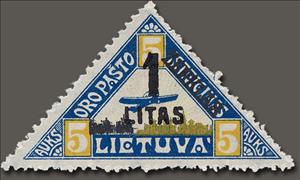Stamp: Plane over Kaunas (Lithuania 1922)
Plane over Kaunas (Lithuania 1922)
10 October (Lithuania ) within release Airmail overprint in new currency goes into circulation Stamp Plane over Kaunas face value 1 Lithuanian litas
| Stamp Plane over Kaunas in catalogues | |
|---|---|
| Michel: | Mi:LT 186 |
| Stamp Number: | Sn:LT C31 |
Stamp is square format.
Printed in Aronshtam and Andreyev lithography (Kaunas) All signs overprints black, except for 30 ct. on 4 auks. stamp, which overprint red. Fakes! Counterfeited LT 181 (20 ct. 2 auks on.) - A lack of overprint CENT.. Similarly, LT 185 (50 ct. Onto 10 auks.), On which secured watermarks . 3 H - horizontal honeycomb. Was rigged and LT 176-180, and triangles LT 186 Variations: A Double overprint, perf 11 1/2 B Double overprint with yellow semicircle C With a dot in the upper rosette D With a yellow semicircle E With a yellow dot in the upper semicircle and rosette F With a yellow semicircle in the second half of another stamp overprint , perf 11 1/2 G Tete Bech couple H Tete- Bech couple, one stamp with a yellow semicircle I. With points lower rosettes (100 pos.) J In the second half of another stamp overprint stamp, perf 11Also in the issue Airmail overprint in new currency:
- Stamp - Air Squadron face value 20;
- Stamp - Plane over Gediminas Castle face value 25;
- Stamp - Plane over Gediminas Castle face value 30;
- Stamp - Plane over Gediminas Castle face value 50;
- Stamp - Plane over Gediminas Castle face value 50;
- Stamp - Plane over Kaunas face value 1;
- Stamp - Winged posthorn face value 10;
- Stamp - Winged posthorn face value 10;
- Stamp - Winged posthorn face value 10;
- Stamp - Airplane over Nemunas River face value 20;
- Stamp - Winged posthorn face value 10;
- Stamp - Air Squadron face value 20;
Stamp Plane over Kaunas it reflects the thematic directions:
A landscape is the visible features of an area of land, its landforms and how they integrate with natural or man-made features. A landscape includes the physical elements of geophysically defined landforms such as (ice-capped) mountains, hills, water bodies such as rivers, lakes, ponds and the sea, living elements of land cover including indigenous vegetation, human elements including different forms of land use, buildings and structures, and transitory elements such as lighting and weather conditions. Combining both their physical origins and the cultural overlay of human presence, often created over millennia, landscapes reflect a living synthesis of people and place that is vital to local and national identity. The character of a landscape helps define the self-image of the people who inhabit it and a sense of place that differentiates one region from other regions. It is the dynamic backdrop to people’s lives. Landscape can be as varied as farmland, a landscape park, or wilderness. The earth has a vast range of landscapes, including the icy landscapes of polar regions, mountainous landscapes, vast arid desert landscapes, islands and coastal landscapes, densely forested or wooded landscapes including past boreal forests and tropical rainforests, and agricultural landscapes of temperate and tropical regions.
In the visual arts, a cityscape (urban landscape) is an artistic representation, such as a painting, drawing, print or photograph, of the physical aspects of a city or urban area. It is the urban equivalent of a landscape. Townscape is roughly synonymous with cityscape, though it implies the same difference in urban size and density (and even modernity) implicit in the difference between the words city and town. In urban design the terms refer to the configuration of built forms and interstitial space.
An aircraft is a machine that is able to fly by gaining support from the air. It counters the force of gravity by using either static lift or by using the dynamic lift of an airfoil, or in a few cases the downward thrust from jet engines. The human activity that surrounds aircraft is called aviation. Crewed aircraft are flown by an onboard pilot, but unmanned aerial vehicles may be remotely controlled or self-controlled by onboard computers. Aircraft may be classified by different criteria, such as lift type, aircraft propulsion, usage and others.
The Kionga Triangle (German: Kionga-Dreieck, Portuguese: Triângulo de Quionga) was a small region of German East Africa situated at the mouth of the Ruvuma River. The Ruvuma served as the border between the German colony and Portuguese Mozambique, and the Kionga Triangle was the only section of German East Africa south of the river. Its principal settlement was Kionga (now Quionga ) which had a population of 4,000 in 1910. It became a German possession in 1894 but came under Portuguese control in April 1916 during World War I. The post-war Treaty of Versailles reaffirmed that the river was the border between Tanganyika, then under British control, and Portuguese Mozambique. The triangle was the only territory that the treaty awarded to Portugal.


